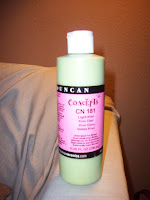

*NOTE* Pictures can be viewed better by clicking and viewing them in isolation.
Source:This piece is made by Elizabeth Prince, who maintains a blog called "gone to pot" and is sold on esty.com.
Technique: Slab-built with a white clay fired to "stoneware temperature" (does this mean low fire, cone 6???). The glaze is a sparkly blue or red that was topped with glass from a cleaned wine bottle which melted in the kiln.
Critique: What first drew my attention to this bowl/tray was the sparkly bottom. From the artist's description the inside of the bowl is smooth, however; the glass pieces give a crackling look that provides visual interest. I really appreciate that the glass was only put on the bottom of the bowl instead of on the petals or on both; the choice to put that crackle looking glass really conveys the look of a flower and the modified stamen/pistol which is at the center. I think this glass and glaze technique is cleaver because convinces the eye of a visual texture while still being smooth. Unlike a more textured piece, with little protuberances or holes, a smooth piece can be more functional as a vessel/tray.
I feel the color choices also affect the impact of these pieces. The blue bowl appears to have a light blue glaze beneath the glass whereas the red bowl has a white with a red border. I think the red bowls appear more washed out; the white center reduces the impact the sparkly glass that is more affective in the blue bowl.
The description of the pieces say the outside was deliberately kept unglazed to provide a contrast and to display the natural beauty of the clay. Are the bumps in the clay a groggy mixture? I assume that the grog is what adds to the strength of the clay, which the artist says is important for this delicate shape. Is that right? Is it easier to make delicate/thin forms with a more groggy clay?










